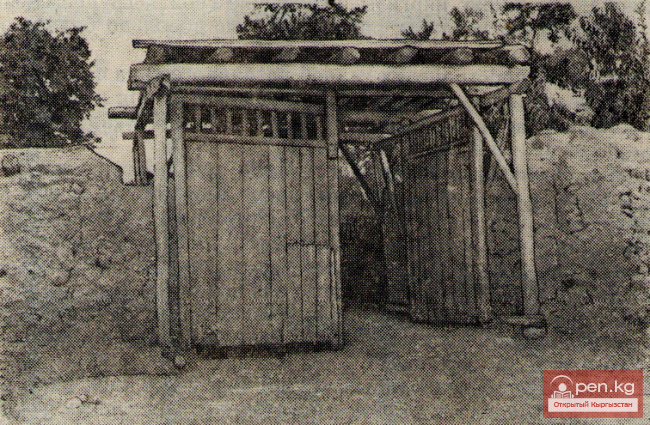The second type of estate is the closed-type estate. It fully embodies the traditions of medieval architecture. It has a rectangular shape, surrounded by a high adobe wall ("duval"), and externally resembles a feudal fortress. Round towers are constructed at the corners and sometimes at the entrance, and the wall features protrusions in the form of battlements. There is usually only one entrance to the estate, typically through high double-leaf wooden gates (darwaza), located in most cases in the middle of its long side.
The gates are usually reinforced with spikes at the base of massive posts buried in the ground and at the upper crossbar.
Above the crossbar, a wooden canopy is arranged, either gabled or flat—acting as a roof that extends over the entrance and continues into the courtyard for two to three meters or more, where it is usually supported by a system of posts and crossbeams.
Behind the wall are residential houses, outbuildings, as well as a vegetable garden, vineyard, and orchard.
Closed-type estates provide a clear representation of social stratification in the past. They primarily belonged to wealthy Kyrgyz who held various positions in the tsarist administration, as well as representatives of the emerging trading bourgeoisie. Some authors attribute the emergence of closed-type estates among the Kyrgyz to around the beginning of the 20th century. However, there is evidence that such estates existed during the period of the Kokand Khanate. A. P. Fedchenko, who traveled through the territory of the modern Frunze district in 1871, left the following information: "All the fields and plantations we saw belong to the Kyrgyz and, I would add, have a Kyrgyz character: these are all solitary burial mounds with a few trees." V. Nalivkin also wrote about such estates inhabited by Kyrgyz in the late 19th century.
The materials we collected also allow us to assert that closed-type estates existed among the Kyrgyz as early as the mid-19th century.
We noted them in the lowland areas of the Frunze, Batken, and Laylak districts.
Usually, closed-type estates are located individually at a significant distance from each other. However, in the village of Samarkandek in the Batken district, where Kyrgyz live (belonging to the groups of Kipchak and Avagat), we encountered estates located quite close to one another.
The territory of the distribution of estates of this type coincides with the territory of settlement of the groups of Kyrgyz united under the name ichkilik. In the eastern part of the modern Osh region, the Kyrgyz did not build "kurgancha" type estates.
Estates surrounded by high walls are common in the Zeravshan Valley among Tajiks, where they are called kala or kurgancha. They are also characteristic of Turkmen. Ancient fortified estates are typical for Uzbeks in Southern Khorezm, where they took the form of a military fortress "with high walls made of 6-7 layers of adobe, surrounding the estate on all sides, including all outbuildings and livestock yards," writes M. V. Sazonova in her research. The presence of castle-like estates in the 18th-19th centuries among large Karakalpak feudal lords is noted by T. A. Zhdanko.
Houses of the Fergana Type
In most of the surveyed closed-type estates, we found houses of the Fergana type with richer architectural decoration of the ayvans and ceilings. In the Frunze district, there are closed-type estates with houses that can be classified as Pamir type, but without stepped vaulted ceilings. An example is the estate belonging to Toichubai Dzhaqibaev, built in 1905 by Dzhaqibai Eshnazarov—Toichubai's father.
The entrance to the estate (Fig. 125) is through large double-leaf gates, in front of which a deep canopy is arranged from the courtyard side.
The estate was built with the expectation that Toichubai, his brother, and son would live in it. Accordingly, the residential units are planned along the "duval." According to the owner, there used to be sheep in the middle of the courtyard. A pen was arranged for them.
A variety of closed-type estate should also be considered estates surrounded by "duval" and having different outlines in plan. They are widely spread in the Osh region, mainly in the west.
Usually, such estates have two exits. One leads to the household plot, and the gate arranged here does not have any special architectural decoration. The other gate is the entrance. It is made double-leaf, massive, and reinforced in a frame with spikes. Sometimes the gate is arranged in a niche facing into the courtyard or slightly protruding towards the street. More often, it is located along the line of the duval, and a flat or gabled canopy is made above it. The height of the gate is 170-180 cm. It is clearly not designed for vehicle entry into the estate, as it is often narrow and has a threshold about 25-30 cm high. Such an entrance is typical for a closed Uzbek estate.
In the courtyard of the estate of Rozni Abdulaeva, built in 1950 (Fig. 126), a large area is allocated for a vegetable garden.

The middle of the courtyard is planted with mulberry trees, creating a large shade in hot weather. One entrance gate leads to the street, and another leads to the household plot occupied by fruit trees.
Green plantings in the courtyards surrounded by fences are characteristic of estates in southern Kyrgyzstan.
Closed-type estates can also conditionally include estates that are enclosed on only three sides. The side of the courtyard that borders the household plot usually remains unprotected. The plan of the estate of Asal Samatova (Fig. 127) represents an example of such a layout.
Interior decoration of the Pamir-type house


